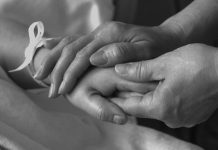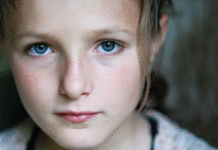In front of the camera, the woman smiles calmly. The dimple on her right cheek, among the wrinkles, shows that Annie has repeated this smile many times in her 81 years of life. Today, however, only her lips are smiling. A strange tension weighs on her eyebrows. Today is the day Annie has decided to die.
“It was very difficult for me to get some sleep last night,” the woman confessed in front of the film crew documenting her final moments. Had she not herself given her consent to this intrusion into one of the most intimate moments of her life, it might have seemed a disgusting injustice to expose her vulnerability just as she was saying her last goodbyes to her loved ones.
Annie has Alzheimer’s. The day the doctor gave her the diagnosis—in fact, the minute she was told—she said out loud to her children who were accompanying her to the doctor, “Okay, then I know what to do.” Both her son and her daughter understood what she meant: euthanasia. In the Netherlands, Annie’s home country, euthanasia is legal, so the woman opted for it without hesitation.
The last day
On her last night, Annie wrote a letter to God asking him to take care of her children. “She knew that if there was a God, he must be a loving and forgiving God,” the woman’s daughter said. Her son quoted from the letter: “Too bad I won’t be able to send an e-mail to my children to tell them how it is.”
When the scheduled day and the doctor arrived, Annie told the documentary director: “I thought about it head-to-head again last night, and in the end this is what I want. Exclusively for me. It’s what’s best for me.” She took the glass without hesitation and complained a little about its bitter taste.
After the woman fell asleep, family members stayed for a while watching her sleep. They stayed like that for some time, the documentary’s director recalls. “She was asleep on the couch, and then she started snoring. And some of the family members began to say: ‘I’m hungry, shall we have a sandwich?’ So we’re all chewing around this lady, who’s sleeping on the couch, and dying. But this shows how normal life takes over, even in a situation like this.” However, the doctor supervising the action was less attentive to the art, and focused on her responsibility there, so proceeded to perform the lethal injection, for fear that Annie might wake up. “It lasted 20 seconds and then it was over,” her son said.
“It’s hard to see your mother dying of euthanasia, but it wasn’t our decision, it was hers,” the woman’s daughter said. The son also confessed: “A good friend of mine said, ‘You have to stop your mother. As a son you have to stop her.’ I said, ‘No, I’m not going to. I support her.’ His mother said [to me], ‘You’re killing your mother, you’re murdering your mother if you go on with this.’ It’s hard to hear.”
Legal requirements
Annie’s particular situation makes the issue of euthanasia all the more disturbing, as she was in the very early stages of Alzheimer’s disease. Her decision to follow through with the procedure had been made before the disease showed itself in full force. While still very lucid, Annie knew that Dutch law, one of the most permissive in the world regarding euthanasia, requires only the consent of those who ask to be euthanised. The same awareness filled her with regret at the thought of giving up her life, which she loved, too soon.
Norway began to debate the issue of euthanasia more seriously in the tumultuous 1970s. But it took three decades for the state to take a permissive stance on medically-assisted death. In 2002, the Dutch authorities registered 1,882 cases, and 15 years later the number had already risen to 6,585. In 2017, patients with dementia made up only 2.6% of all those requesting euthanasia. Most patients seeking medical attention for this purpose were cancer patients (64.3%).
Under current law, a person requesting to be euthanized must do so for medical reasons, so they are considered a patient. The law stipulates that, first of all, the patient needs to convince their doctor that their decision to request euthanasia is not being forced upon them by anyone, that it is based on the fact that their life is, or will become, one marked by “unbearable suffering, without the prospect of improvement”, and that they have “no reasonable alternative.” Another doctor also needs to do an independent evaluation and concur with the first doctor’s view.
In light of these provisions, the waters are very murky for Alzheimer’s patients. In order to convince their doctors that their decision to be euthanised is a personal one and is not being imposed by anyone, patients must still be in the early stages of the disease, before it deprives them of their full mental faculties.
Paradigm shift
In 2004, two years after the legalization of euthanasia, the first case involving an Alzheimer’s patient took place. In 2017, 166 such patients received the procedure at an early stage of the disease, and only 3 at an advanced stage. But there is currently an increase in the number of these patients. Medical ethicist Berna van Baarsen is convinced that in the future the number of euthanasia cases for Alzheimer’s will increase. Van Baarsen was part of a committee that reviewed euthanasia requests in one region of the Netherlands. She had resigned, disturbed by the ease with which difficult cases are approved for euthanasia.
“I have seen the shift,” she says. “The problem is that the shift is very difficult to catch. But it is happening. It’s happening under your nose, and in the end you realise there has been a shift.”
Van Baarsen believes that doctors rely too heavily on written statements that patients seeking euthanasia send to doctors in the early stages of a disease.
“You can write down what your fears are. What you don’t want to experience. But it is a wish. It is an expression of fear, and as we know, people change,” van Baarsen says. “In the beginning they say: ‘Oh no, I don’t want to live in an old people’s home,’ or, ‘I don’t want to be put in a wheelchair,’ and it happens. People always find ways to cope. That’s the beautiful thing about being human.” Therefore, the specialist argues that before helping someone die, doctors must check if the patient still wants to die. But in patients with advanced dementia, this is not always possible. “If you can’t talk to a patient, you don’t know what the patient wants,” van Baarsen says.
The issue of the crucial decision is often at the heart of the euthanasia dilemma. Recently, also in the Netherlands, a doctor was prosecuted after giving a lethal injection to a 74-year-old woman. She had signed a written statement requesting euthanasia, but only when she said she was ready. On other occasions, however, she said she did not want to be euthanised. The doctor who worked in the nursing home where the woman was living put a sedative in her morning coffee one day, without telling her. The patient fell asleep and the doctor proceeded to give her the lethal injection, but the woman woke up just as he was trying to euthanise her. She began to struggle, and her relatives immobilized her until the procedure was over, the press wrote, noting that “the level of restraint used is disputed.”
The coordinating chairman of the Dutch review committees, which examine every euthanasia case, Jacob Kohnstamm, said that the doctor had obviously overstepped his boundaries. “The commission said the written declaration wasn’t good enough, and the doctor should have stopped the procedure the moment the patient got up,” Kohnstamm said.
The committee decided that the doctor had not acted in accordance with his duties and referred the case to prosecutors. The trial, the first of its kind, will be one that will have a huge influence on how Dutch doctors relate to euthanasia. For some practitioners, however, especially for those who have already clarified their position, this is not necessarily good news.
Constance de Vries, the doctor who treated Annie, has no dilemma about ending the lives of patients who have difficulty expressing their wishes, as long as they have always been very clear about their wishes when they have them. De Vries told a BBC reporter about a patient of hers who “was very unhappy; she cried, screamed, did not eat, did not sleep, was aggressive with other people. When you saw her, you realised how unhappy she was. And in her statement she had stated from the beginning: ‘I want to die when I will no longer recognise my grandchildren.'” When the time came, de Vries scheduled the euthanasia, with the support of the woman’s family. “When I gave her a glass of fruit juice, I said, ‘When you take it, you will sleep forever.’ She looked at her daughter, and the daughter said, ‘It’s okay, mum.’ And she took it. I don’t know if she did understand fully, but I know what we did was okay, so unhappy was she.” De Vries says she is worried about the first prosecution of a doctor for euthanasia in the Netherlands. But she says she doesn’t intend to stop. It will be more difficult, she admits, for patients with advanced dementia, but also for those with early dementia, who will have to request euthanasia earlier.
Should we talk about death?
The various scenarios that are at play when it comes to euthanasia, at a time when many countries are debating the benefits and risks of legalising this action, once again show how disconnected the inhabitants of developed, Western societies are from the events that precede or constitute someone’s death. For Western society, death as a topic is still taboo. Its last faithful witnesses is the media, which often portrays it in a reductionist manner, and medical institutions, which by their nature transmit only its sanitised aspects. In the past, however, people had direct contact with death, within their multigenerational families, in which the elderly were accompanied on the way to their last moments by the younger ones. This fellowship reassured the dying as well as the remaining, teaching them that death is a necessary step to the end of life.
Today, people are as aware of their mortality as they were in the past. But the volume of knowledge about what happens around death, what a dying man experiences and how death happens, is crushed against a wall of politeness, which forces us not to debate topics considered disturbing.
“Since no one teaches us how to die, most of us face the reality of death when we face our own death,” notes Christian author Roberto Badenas in his book “Facing Suffering”. However, the author showed that the taboos we have built around death prevent us from living with dignity.
A study by the VCU Massey Cancer Center, cited by Badenas on preparing people for death, shows that at least 20% of terminally ill patients receive chemotherapy or intensive care in their last week of life. “If they had known their prognosis, they might have chosen to have a less painful and quieter end,” Badenas wrote. “Efforts to prolong biological life, as if it were an absolute value in it, can turn healing into torture,” added the author, who, aware of the limitations of his own statement, added that the goal is to “eliminate suffering, not the sufferer. From a religious point of view,” Badenas noted, “wanting to die when what you actually want is to rest and stop suffering cannot be against God’s will, because He can only desire what is good for us.” But who can guarantee that there is an equal relationship between the good we can conceive of and the good that God can conceive of?
From experience
Badenas’ book was published in October 2013, before the first requests for euthanasia due to “terminal depression” appeared in the medical institutional space. In 2016, the story of young Emily, who decided to die at the age of 24, had a bright end. On the eve of what she had decided would be her final day, the young woman from Belgium thought that she could still fight the depression that was torturing her. Two years later, however, Emily rescheduled her euthanasia and, on August 25, 2018, she received the lethal injection. Eight months before Emily’s death, another 29-year-old girl, Aurelia Browers, requested euthanasia, also due to “terminal depression”, in the Netherlands. Less than a month after receiving the euthanasia eligibility certificate, Aurelia also ended her life. Both Emily and Aurelia did not want to reject life, they just wanted to stop suffering.
This does not mean, however, that “terminal depression” was as real as they claimed, or that their desire to die was really a remedy for suffering, not a symptom of it.
Depression is a condition often associated with terminal illness, but the notion of “terminal depression” does not exist in the medical vocabulary. For the authorities in Belgium and the Netherlands, however, the desire of the two women to die mattered more than the fact that this desire was most likely a symptom of depression and that fulfilling it should not be considered a solution. This demonstrates how difficult it is to build a truly protective law in the field of euthanasia, and how deeply limited even the legislation considered to be the most advanced in the world in this regard actually is.
What legal guarantees can societies living at the paradoxical intersection of two opposites hope for: people who do everything they can to prolong biological life, regardless of expense and suffering, and people who do everything they can—including dying—to get rid of suffering? Looking at the two opposites, it seems that they still have one thing in common: suffering.
That is why, perhaps, before we talk about death and try to build a legislative fence around it, it would be better to talk about suffering and what real solutions we have for it. Of course, this is not the purpose of the law, but the purpose of other shaping factors, especially one whose roots are deeply nourished by suffering, death, and resurrection, in a setting of love. Christianity, with its origin in the sacrifice of Christ, certainly has an expansive vision on the subject of suffering—but its vision is not limited to suffering itself: it also has the legitimacy to teach this vision to society as a teacher who can speak not only from books, but also from experience.



















